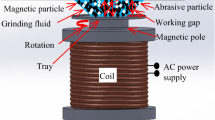Abstract
This paper describes a new ultra-precision magnetic abrasive finishing (MAF) process using alternating magnetic field. The process principle and the finishing characteristics are described. Specifically, the effects of finishing parameters such as cutting fluid, rotational speed of magnetic pole, and current frequency on change in material removal and surface finish are investigated respectively. Experimental results indicate that neat cutting oil is more suitable for this processing, which can obtain higher material removal and smoother finished surface compared with water-soluble cutting fluid and silicone fluid. The finishing force and material removal are gradually increasing with the increase of rotational speed of magnetic pole. It is confirmed that the angle variation of magnetic particles is decreasing with the increase of current frequency, and the few nanometer surface can be acquired in the condition of low frequency.
Similar content being viewed by others
References
Shinmura T, Takazawa K, Hatano E, Matsunaga M, Matsuo T (1990) Study on magnetic abrasive finishing. CIRP Annals- Manuf Technol 39(1):325–328
Zou Y (2012) Internal finishing of micro tubes by the magnetic abrasive finishing. J Jpn Soc Abras Technol 56(2):86–89 (in Japanese)
Kang J, Yamaguchi H (2012) Internal finishing of capillary tubes by magnetic abrasive finishing using a multiple pole-tip system. Precis Eng 36(3):510–516
Amineh SK, Tehrani AF, Mohammadi A (2013) Improving the surface quality in wire electrical discharge machined specimens by removing the recast layer using magnetic abrasive finishing method. Int J Adv Manuf Technol 66:1793–1803
Lee YH, Wu K-L, Bai CT, Liao CY, Yan BH (2015) Planetary motion combined with two-dimensional vibration-assisted magnetic abrasive finishing. Int J Adv Manuf Technol 76:1865–1877
KWAK JS (2009) Enhanced magnetic abrasive polishing of non-ferrous metals utilizing a permanent magnet. Int J Mach Tool Manuf 49:613–618
Wang Y, Hu D (2005) Study on the inner surface finishing of tubing by magnetic abrasive finishing. Int J Mach Tool Manuf 45:43–49
Shinmura T, Takazawa K, Hatano E, Aizawa T (1984) Study on magnetic abrasive process (finishing characteristics). Bull Jpn Soc Precis Eng 18(4):347–348
Shinmura T, Takazawa K, Hatano E, Aizawa T (1985) Study on magnetic abrasive process (process principles and finishing possibility). Bull Jpn Soc Precis Eng 19(1):54–55
Singh DK, Jain VK, Raghuram V (2005) On the performance analysis of flexible magnetic abrasive brush. Mach Sci Technol 9:601–619
Singh DK, Jain VK, Raghuram V, Komanduri R (2005) Analysis of surface texture generated by a flexible magnetic abrasive brush. Wear 259:1254–1261
Singh DK, Jain VK, Raghuram V (2006) Experimental investigations into forces acting during a magnetic abrasive finishing process. Int Adv Manuf Technol 30:652–662
Yin S, Shinmura T (2004) Vertical vibration-assisted magnetic abrasive finishing and deburring for magnesium alloy. Int J Mach Tool Manuf 44:1297–1303
Yin S, Shinmura T (2004) A comparative study: polishing characteristics and its mechanisms of three vibration modes in vibration-assisted magnetic abrasive polishing. Int J Mach Tool Manuf 44:383–390
Mulik RS, Pandey PM (2011) Magnetic abrasive finishing of hardened AISI 52100 steel. Int J Adv Manuf Technol 55:501–515
Mulik RS, Pandey PM (2011) Ultrasonic assisted magnetic abrasive finishing of hardened AISI 52100 steel using unbonded SiC abrasives. Int J Refract Met Hard Mater 29:68–77
Kala P, Pandey PM (2015) Comparison of finishing characteristics of two paramagnetic materials using double disc magnetic abrasive finishing. J Manuf Process 17:63–77
Zou Y, Shinmura T (2009) Study on a new plane magnetic abrasive finishing process by application of a constant pressure magnetic brush. J Jpn Soc Abras Technol 53:31–34 (in Japanese)
Jiao AY, Quan HJ, Li ZZ, Zou YH (2015) Study on plane magnetic abrasive finishing process (characteristics of finished surface). Int J Adv Manuf Technol 80:1613–1623
Wu JZ, Zou Y (2013) Study on ultra-precision plane magnetic abrasive finishing process by use of alternating magnetic field. Appl Mech Mater 395–396:985–989
Natsume M, Shinmura T (2008) Study on the mechanism of plane magnetic abrasive finishing process (elucidation of normal force characteristics). Trans Jpn Soc Mech Eng 74(737):212–218 (in Japanese)
Author information
Authors and Affiliations
Corresponding author
Rights and permissions
About this article
Cite this article
Wu, J., Zou, Y. & Sugiyama, H. Study on finishing characteristics of magnetic abrasive finishing process using low-frequency alternating magnetic field. Int J Adv Manuf Technol 85, 585–594 (2016). https://doi.org/10.1007/s00170-015-7962-9
Received:
Accepted:
Published:
Issue Date:
DOI: https://doi.org/10.1007/s00170-015-7962-9




